Detailed Report by Watersheds : 'Ducasse Reservoir-180800020205'
Brown Trout
-
Scientific NameSalmo trutta
-
NativeNo
-
Identification
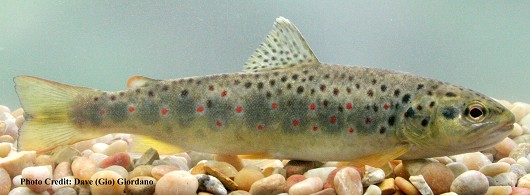 Brown trout, approximately 20 cm (8”) long. Location: Deer Creek, California Date: 6/21/2007.
Brown trout, approximately 20 cm (8”) long. Location: Deer Creek, California Date: 6/21/2007.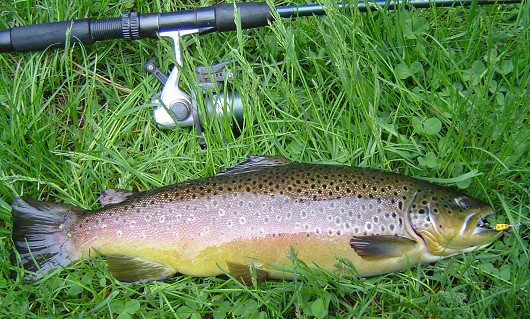 Brown trout. Photo by Dan Worth, California Department of Fish and Game.
Brown trout. Photo by Dan Worth, California Department of Fish and Game.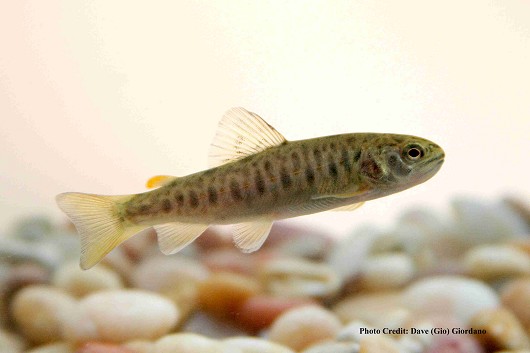 Brown trout, approximately 7 cm (2.5”) long. Location: Deer Creek, California Date: 6/21/2007
Brown trout, approximately 7 cm (2.5”) long. Location: Deer Creek, California Date: 6/21/2007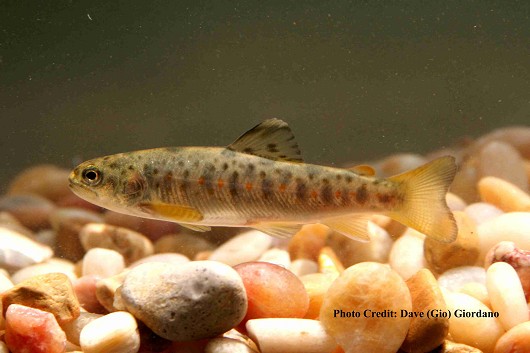 Brown trout, approximately 7 cm (2.5”) long. Location: Deer Creek, California Date: 6/21/2007
Brown trout, approximately 7 cm (2.5”) long. Location: Deer Creek, California Date: 6/21/2007- Heavy bodied with a large mouth often extending beyond the rear margin of the eye
- Well developed teeth on both jaws
- 12-14 dorsal, 10-12 anal, 9-10 pelvic, and 13-14 pectoral fin rays
- Thick caudal peduncle with a straight tail in adults and a slightly forked tail in juveniles
- Males have a rounded anal fin while that of females is slightly indented
- 120-130 small scales on the lateral line
- Dark to olive brown on the back, yellow brown on the sides, white to yellow on the belly, and red or orange adipose fin
- Black spots on the gill covers, head, sides (usually with a pale halo), tail, and the adipose and dorsal fin
- Red spots on the lower sides (only trout with both red and black spots)
-
Life History
Brown Trout can be found in a large variety of waters, from spring fed trickles to large lakes and reservoirs, but find their optimal habitat in medium to large, slightly alkaline, clear streams, with swift ripples and deep pools. In general, as the trout get older they move towards deeper waters with fry staying in low velocity edge waters less than 30 cm deep, juveniles found in higher velocity water 50-75 cm deep with large rocks, logs, and overhead cover, and adults keeping to pools 0.7-3.5 m deep. There are also differences in habitat based upon the trout’s maturity level. Non-reproducing fish are usually sedentary, staying near or under the same piece of dense cover constantly, but reproducing fish will establish a feeding territory and actively protect it. As the fish get larger their territory will expand until they reach approximately 25 cm in length. At this point they become more mobile, staying under cover during the day, but patrolling a larger area at night for active feeding. Although temperatures of 28-29°C can be survived for a short period of time, Brown Trout are generally cold water fish, preferring temperatures between 12°C and 20°C. Brown Trout may also be sea run, particularly in their native Europe, North Africa, and western Asia, but this is rare in California.
The diet of a Brown Trout can change dramatically over the course of its lifetime. Smaller individuals focus on drift organisms, in particular terrestrial insects, before shifting to more bottom dwelling invertebrates as they get larger. By the time they are 25 cm in length and have moved away from a feeding territory they will actively pursue other fish, crayfish, and dragonfly larvae; Brown Trout over 40 cm feed almost exclusively on other fish. All sizes will eat terrestrial insects in late summer when there are massive hatching events creating a large enough supply of food to support even the largest individuals. They will feed at any time of the day but most intensely at dusk and dawn. Individuals may become specialized at hunting one certain type of prey while others are generalists in their prey choices. This results in a wide diversity of diets within a population.
Maturity is usually reached in the 2nd or 3rd year and breeding occurs in November and December. A rise in water level signals the trout to head to spawning territory but the final redd site is not selected until temperatures drop below 6-10°C. Streams with riffles that have pea- to walnut-sized gravel are usually required for spawning, with the best locations at the tails of pools with deeper, less turbulent water, and more complete cover. A female constructs the redd in the gravel bottom while the male protects and courts her. Once the redd is complete the pair will hold position next to each other and release their eggs and sperm simultaneously. After fertilization the female will, in a single shift of gravel, bury the eggs she has just laid and construct a new redd for the next batch. Each redd will hold 100 to 250 eggs and a female can lay between 200-21,000 over the course of a breeding season. This difference in fecundity can sometimes be based on the trout’s surroundings. In heavy cover it is more common to find large eggs in smaller numbers while females in areas of lighter cover tend to produce a greater number of smaller eggs. It can take anywhere between 4 and 21 weeks for the embryos to hatch, but 7-8 weeks is the norm. Alevins will emerge 3-6 weeks later and move towards calm, nearshore waters where they find cover among large rocks and under overhanging plants.
These young trout will grow to 3-8 cm in length their first year and 7-22 cm in their second. This diversity can be caused by differences in temperature, alkalinity, dissolved solids, turbidity, population density, or food availability. The largest individual ever recorded was a 103 cm long fish from Scotland and the largest California fish was measured at 12 kg. Norwegian Brown Trout have been known to live as long as 35 years but in California 9 years old seems to be the limit.
-
Links to Other Research
Effects of Pulsed Flows from Dams on Fishes: Field and Lab Studies (see 1-day pulse study for brown trout data)
Coastal Rainbow Trout
-
Scientific NameOncorhynchus mykiss irideus
-
NativeYes
-
Identification
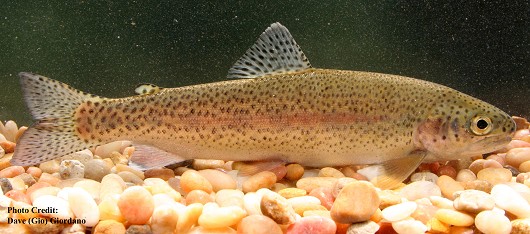 Rainbow trout, 18 cm (7”) long. Location: Deer Creek, California (Yuba River basin). Date: 6/21/2007.
Rainbow trout, 18 cm (7”) long. Location: Deer Creek, California (Yuba River basin). Date: 6/21/2007.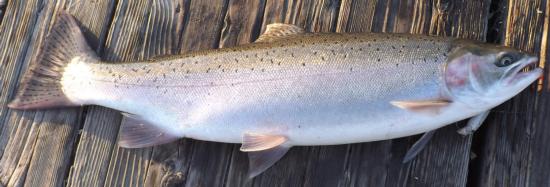 Steelhead. Caught and released in the South Fork Mokelumne River, San Joaquin County, CA, 18 Oct 2013. Photo by Gary Riddle.
Steelhead. Caught and released in the South Fork Mokelumne River, San Joaquin County, CA, 18 Oct 2013. Photo by Gary Riddle.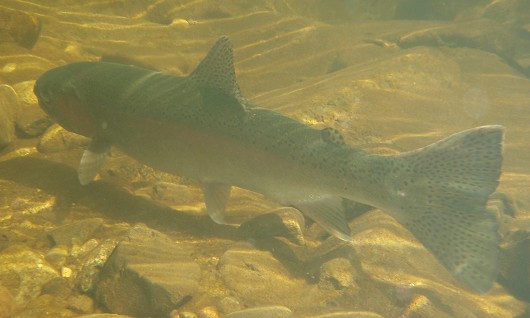 Steelhead in a Santa Monica Bay coastal stream, southern California, in February 2009. Photo by Steve Williams, The Resource Conservation District of the Santa Monica Mountains. California Department of Fish and Game provided funding for the study.
Steelhead in a Santa Monica Bay coastal stream, southern California, in February 2009. Photo by Steve Williams, The Resource Conservation District of the Santa Monica Mountains. California Department of Fish and Game provided funding for the study.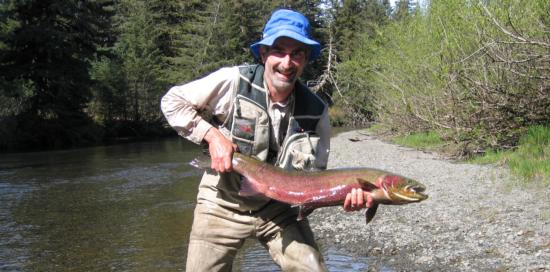 Steelhead. Location: A river in Alaska. Photo courtesy of Steve Tjosvold, UC Cooperative Extension.
Steelhead. Location: A river in Alaska. Photo courtesy of Steve Tjosvold, UC Cooperative Extension.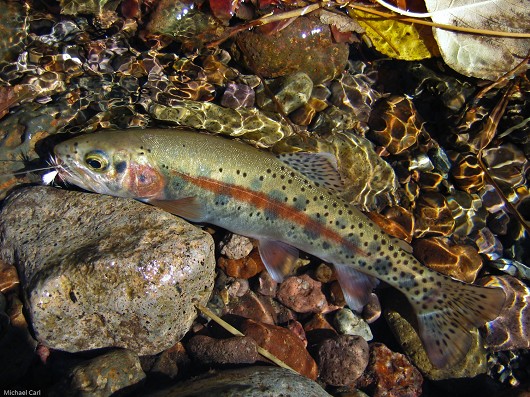 Rainbow trout (McCloud River redband), photographed at Trout Creek, California in October 2006. Photo by Michael Carl.
Rainbow trout (McCloud River redband), photographed at Trout Creek, California in October 2006. Photo by Michael Carl.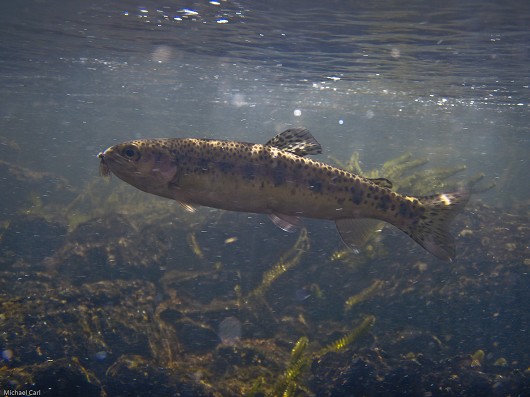 Rainbow trout (Warner Lakes redband), photographed at Mud Creek, Oregon in July 2009. Photo by Michael Carl.
Rainbow trout (Warner Lakes redband), photographed at Mud Creek, Oregon in July 2009. Photo by Michael Carl.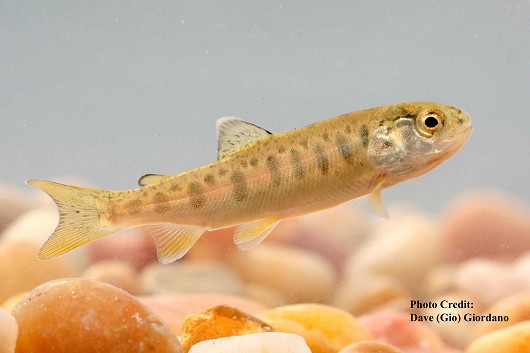 Rainbow trout fry, redband sub-species. Date: 7/10/2007.
Rainbow trout fry, redband sub-species. Date: 7/10/2007.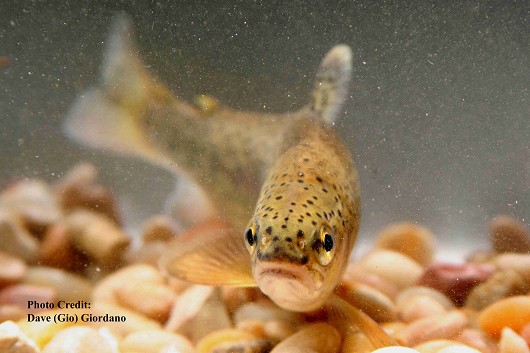 Rainbow trout, frontal view. Location: Deer Creek, California (Yuba River basin). Date: 6/22/2007.
Rainbow trout, frontal view. Location: Deer Creek, California (Yuba River basin). Date: 6/22/2007.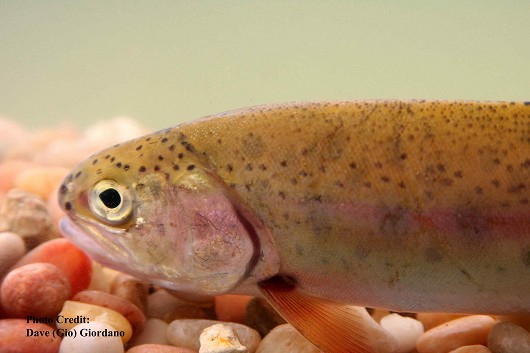 Rainbow trout, head. Date: 7/10/2007.
Rainbow trout, head. Date: 7/10/2007.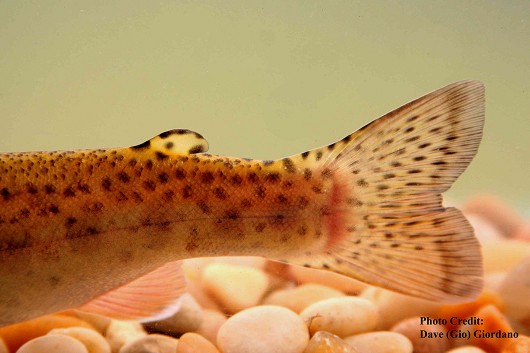 Rainbow trout, tail. Date: 7/10/2007.
Rainbow trout, tail. Date: 7/10/2007.PLEASE NOTE: The photos and information shown here are for Rainbow Trout / Steelhead, of which Coastal Rainbow Trout is a sub-species.
- Commonly 35-65 cm FL and 1.4-5.4 kg; largest in CA, 12.4 kg steelhead
- Large mouth with teeth on both upper and lower jaws
- Silvery body, black spots on the adipose, dorsal, and caudal fins, pink to red lateral band
- Juvenile fish have similar appearance, possess 5-13 dark spots called parr marks that run laterally along fish’s body, parr marks are smaller than the gaps between them
- Young fish also have 5-10 dark dorsal spots between the head and dorsal fin
- Steelhead usually lighter in color than resident rainbow trout
- Fin rays: dorsal 10-12, anal 8-12, pelvic 9-10, pectoral 11-17
-
Life History
Rainbow Trout are by definition a cold water fish. Optimal growth occurs at 15-18ºC and mortality typically results at 24-27ºC. New research is revealing populations of trout that are sustaining life in conditions previously considered lethal. Trout or Steelhead require near saturation levels of dissolved oxygen to grow, though these fish can live at levels as low as 1.5-2.0 mg/L. Oncorhynchus mykiss generally have one of two distinct life patterns: resident inland trout and sea-run or anadromous Steelhead. Some inland trout do migrate for the purpose of spawning or food foraging. Resident forms of O. mykiss often spend their entire lives within a few hundred meters of stream or within the same lake. Steelhead or sea-run trout hatch in freshwater and then migrate to the ocean, finally returning home to spawn. Times spent in freshwater and in the ocean vary according to geography, life history patterns, and effects of natural phenomena. Spawning occurs in places where the streambed is composed of gravelly substrate, usually in riffles or pool tails. The female fish digs a redd (nest) and deposits 200 to 12,000 eggs depending upon her body size. Resident Rainbow Trout usually produce less than 1,000 eggs per year while Steelhead may produce up to 2,000 eggs per kg of body weight. After breeding the resident trout disperse to slower waters and the Steelhead rest before moving back out to sea. In 3-4 weeks the eggs hatch and the young trout spend another 2-3 weeks under the cover of the gravel before emerging as fry. In some instances the fry of anadromous Steelhead will emerge soon after hatching and swim straight to the ocean to avoid dry summer periods. Typically the young Steelhead or parr reside in freshwater for 1-3 years before smoltification (transition to being able live in salt water). When the smolts finally reach the ocean they begin feeding on estuarine invertebrates, krill, and then focus on fish. Steelhead may stay in saltwater for 1-2 years before returning to their native streams. Most anadromous salmonids die after spawning but Steelhead may make numerous trips back and forth between fresh and salt water to breed. Steelhead may spawn up to four times per life span, though the mortality rate between successive cycles is high. Rainbow Trout do not commonly live beyond 6 years, though fish have been recorded to reach 9-11 years. Within a stream resident rainbows and freshwater phase Steelhead have in-stream habitat preferences generally determined by size. The smallest fish are mostly found in riffles, medium sized fish in runs, and larger fish predominantly in pools. In streams and lakes Rainbow Trout feed on zooplankton, invertebrates, insects, drifting organisms, and sometimes other fish. Feeding usually peaks at dawn and dusk and summer consumption is greater than that in winter.
Video of Rainbow Trout:
Rainbow trout in Cow Creek, 7 June 2005. Videography by Richard Enos. Edited by Lisa Thompson, with permission. Some of this video footage was originally shown in the KVIE documentary "Sacramento: River of Life", produced by Craig Miller.
-
Links to Other ResearchN / A
Lahontan Redside
-
Scientific NameRichardsonius egregius
-
NativeYes
-
Identification
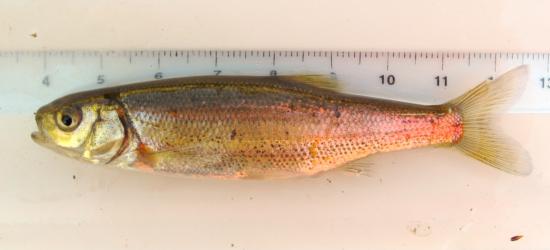 Lahontan redside, caught in Bogard Spring Creek (Eagle Lake watershed) in 2011. Photo by Teejay O'Rear. Scale in cm.
Lahontan redside, caught in Bogard Spring Creek (Eagle Lake watershed) in 2011. Photo by Teejay O'Rear. Scale in cm.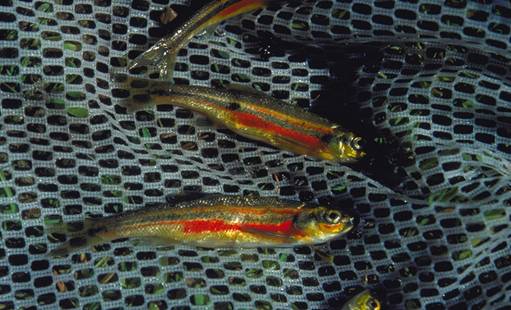 Lahontan redside. Photo courtesy of Professor Peter B. Moyle.
Lahontan redside. Photo courtesy of Professor Peter B. Moyle.- Small, skinny minnow (TL 4 x body depth), max. length 16 cm TL
- Large eyes, deeply forked tail, terminal mouth (maxilla only reaches front end of eye)
- Breeding adults: red or scarlet lateral band amidst yellow, olivaceous back, silver underside, breeding tubercles present
- Males: tubercles larger and more numerous, present on pectoral fins, darker colorations, pectoral fins reach pelvic origin when depressed
- Non-breeding adults: red-stripe reduced or absent, lateral band still visible
- Fin Rays: dorsal 7-8, anal 8-20
- Lateral Line Scales: 52-63
-
Life History
Lahontan Redsides are native to both lakes and streams on the eastern side of the Sierra Nevada mountain range, although they have been introduced to the upper reaches of some watersheds on the western side of the range. River and stream inhabitants tend to occupy different niches within the waterway depending upon size. Adults hold in the top of pools near salmonids while the juvenile fish stick closer to the stream margins. The diet of stream residents may include drifting insects as well as benthic insects and algae. They tend to feed at night in order to avoid predators such as birds. Lahontan Redsides may have important interactions with other species such as Tahoe Suckers and Brown Trout. Sucker populations may suffer when their eggs provide food and nutrients for the Lahontan Redsides, whereas the Brown Trout can prey heavily upon the Lahontan Redside and limit their populations. Lahontan Redsides living in lakes tend to shoal and forage by swimming in the littoral zone. A diet study in Lake Tahoe found that these fish feed on both benthic and surface organisms, though primary food targets may vary highly throughout the day. In Eagle Lake the primary constituents of the Lahontan Redside diet include caddisfly larvae, planktonic cladocerans, and amphipods. Lahontan Redsides reach sexual maturity in the summer of year 3-4, and their growth rates are similar everywhere though fish in colder waters tend to grow slightly slower. Spawning occurs between late May and August with a peak at the end of June. During this time lake-dwelling Lahontan Redsides often move up into tributary streams to breed. Spawning takes place over gravel in riffles or pool tails. Females in Lake Tahoe produce and average of 1,125 eggs. Groups of 20-100 fish swim over the spawning gravels and release their eggs and milt. The fertilized eggs become lodged in the substrate where they will incubate and later hatch. The newly hatched young swim down to slow water at the mouth of the spawning stream and hide in shoals under cover. The Lahontan Redside has a maximum lifespan of around 5 years.
-
Links to Other ResearchN / A















